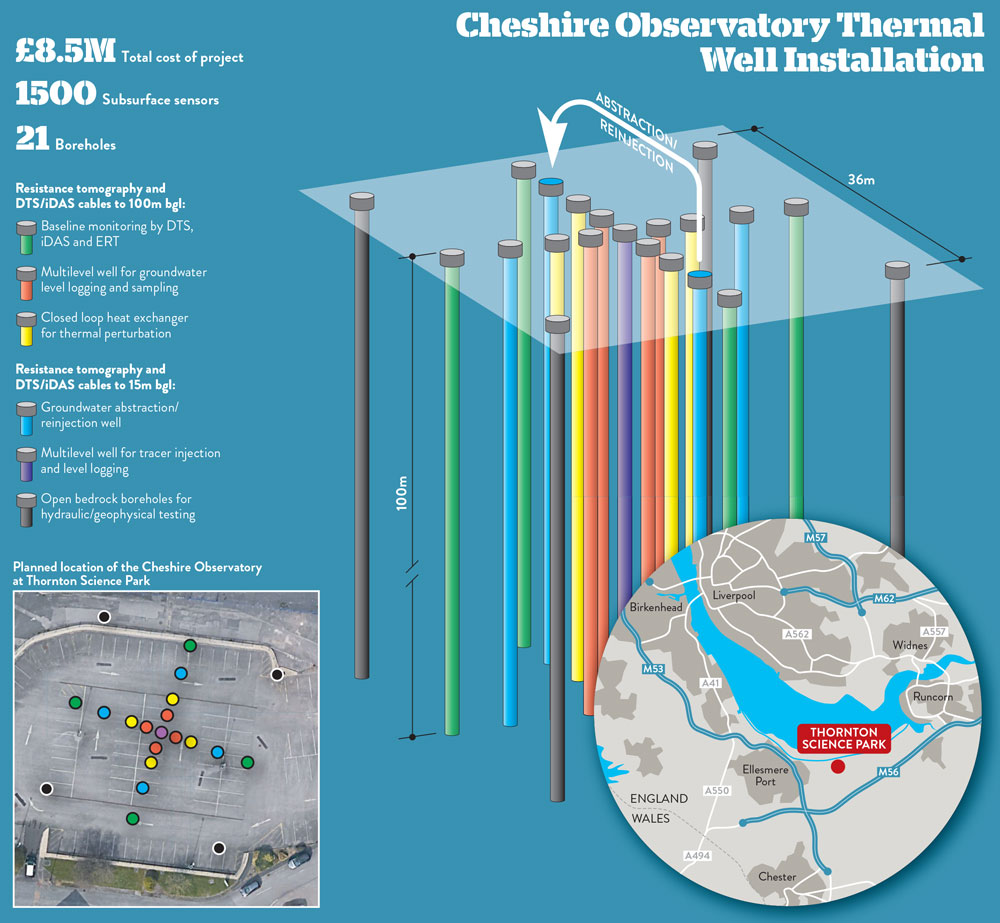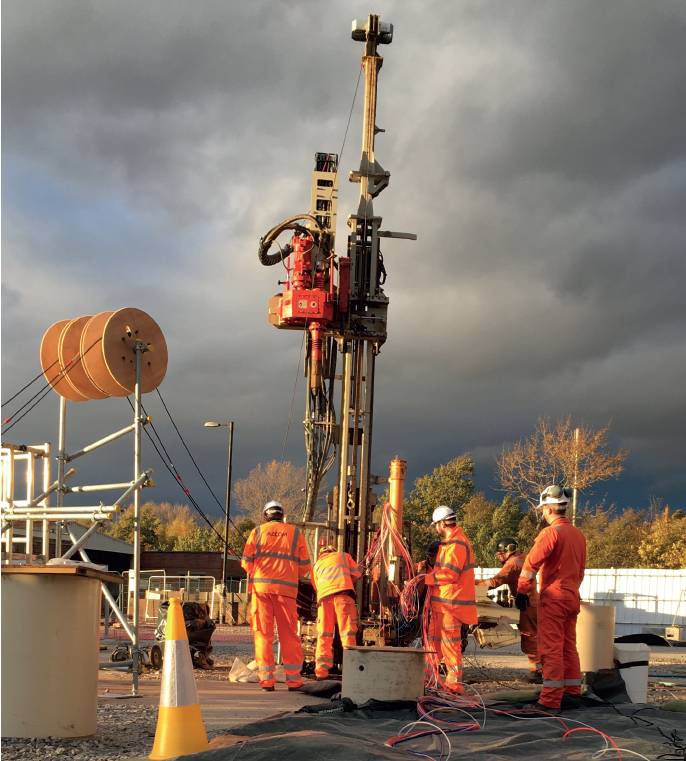Innovative Thinking | Thermal energy research
Looking deeper
Boreholes equipped with advanced subsurface sensing technologies have been driven in Cheshire to investigate the use of underground aquifers for thermal energy storage. Kristina Smith reports.
Something very exciting has been happening in one of the University of Chester’s car parks at Thornton Science Park. Or rather, under it.
Since May 2022, consultant Aecom has been involved in creating an £8.5M underground geo-energy observatory for its client the British Geological Survey (BGS).

The Cheshire Observatory aims to provide new information about the way fluids and heat move through the Sherwood Sandstone aquifer beneath it. It is also measuring the impact of heat storage on the aquifer. To do this, it has created a configuration of 100m deep boreholes with diameters of 152mm to 222mm, equipped with more than 1,500 subsurface sensors.
This aquifer is a good candidate for producing shallow geothermal energy due to its high thermal conductivity, high porosity and high permeability. The observatory will help reveal how features such as faults, deformation and layering of different sediments influence subsurface heat flow.
The goal is to work out how aquifers could be used to heat and cool buildings, reducing reliance on fossil fuels and electricity.
Findings from the Cheshire Observatory could inform other potential uses of this type of aquifer, says BGS director of science for the UK Geoenergy Observatories Mike Spence. The same rock formation lies under the North Sea and the East Irish Sea, where CO2 storage is being considered. Sherwood sandstone could also provide a reservoir for storing hydrogen or compressed air.
The Cheshire Observatory is part of the wider £31M UK Geoenergy Observatories project. It incorporates an observatory in Glasgow which is investigating the geothermal potential of flooded former mine workings. The project also includes a high resolution core scanning facility at the BGS headquarters in Keyworth, Nottingham.
KEY FACTS
3mDistance between boreholes at the centre of the array
1,100Electrical resistivity tomography electrodes at 1m vertical space
CONFIGURATION
The 21 boreholes – one of which was an exploratory one sunk before Aecom’s contract began – are within a 36m by 36m area. They are equipped with advanced fibre optic and geoelectrical sensors and are closely spaced – just 3m apart at the centre of the array – to allow detailed mapping of thermal transport.
There are six different borehole functions. At each corner of the site is an open bedrock borehole for geophysical and hydrogeological investigations. Four borehole types sit in two lines, forming a cross. Each line has two groundwater abstraction/ reinjection wells; two multilevel wells for groundwater level logging and sampling; two closed loop heat exchangers; and two boreholes for baseline monitoring – all 100m below ground level. Where the two lines of boreholes meet, there is a multilevel well with removable lines designed to meet requirements of different experiments including tracer injection and level logging.
The boreholes are equipped with active distributed temperature sensing (active DTS); intelligent distributed acoustic sensing to measure strain (iDAS); and electrical resistivity tomography (ERT) for imaging the subsurface.
In addition, the four heating and cooling boreholes are equipped with an internal passive DTS fibre loop that will be used to continuously monitor the temperature of the circulating fluid in them.
Spence describes how the ERTs and fibre optic cables will complement each other: “We have installed more than 1,100 ERT electrodes at 1m vertical spacing in the centre of the array measuring changes in rock volume that affect the electrical resistance of the rock.
“We are looking for changes in resistance between electrodes in different boreholes. This can provide advance notice of temperature changes in the rock volume before a thermal plume reaches the installed fibre optic cables, which give readings at a particular place.”
Boreholes at the centre and outer corners of the array provide direct access to the bedrock for tracer injection and geophysical testing.
“The density of cored, instrumented, boreholes gives excellent ground truth
These boreholes are also available for the deployment and benchmarking of new sensor and thermal technologies that may arise over the facility’s 15-year-plus life, says Spence.
This density of sensors and the resulting capability of the system make it a unique facility, says Spence: “The density of cored, instrumented, boreholes gives excellent ground truth. It opens up the possibility of near real-time imaging of subsurface processes. For example, a 3D image of a thermal plume, or the change in the water chemistry moving through that subsurface volume.”
The close proximity of the boreholes also means that experiments can be conducted more quickly – in weeks rather than months or years. Heat transfer happens quite slowly, so shorter distances between monitoring points mean data is available sooner.
For Aecom, which is constructing the observatory, the density of the boreholes and the unique combination of sensor technologies has meant that ingenuity has been required at almost every turn, says the firm’s project director Richard Nicholson.
“There has been a lot of problem solving because of the unique nature of the project.
“A lot of the suppliers have said ‘we have not done that before’ so we have been working with them to supply bespoke installations in collaboration with the client,” he says.
CONSTRUCTION AS RESEARCH
Aecom started on site at the beginning of July 2022, having been awarded the contract in May that year. Ramboll is the lead designer.
This was a very hands-on job for Aecom project manager Lucy Ford and her team. For each installation of borehole sensors, the cables were fanned out across the car park ready to feed into the borehole.
Ford describes the painstaking preparations that took place at ground level beforehand, from testing all equipment to personally running her finger along sensor cables to check for nicks and grit.
Constructing the facility was a research exercise in itself. Each borehole was drilled and then equipped with sensors – rather than drilling them all and then installing the instrumentation – so that the impact of new boreholes on existing ones could be observed.
Chemical and microbiological analysis of samples from the drill cores took place in a field laboratory before the cores travelled to Keyworth for scanning. BGS will use the data collected to create a 3D underground model of the aquifer.
“There has been a lot of problem solving because of the unique nature of the projectA panel of industry and academic experts from around the world helped inform the design, with input from other interested scientists and researchers.
Spence gives an example: “We heard from one research group which advised us it was possible to put fibre optic monitoring cables through the inside of the borehole heat exchanger, although it was very difficult. They said it had been successful in one or two cases.”
It was not possible to pre-install the fibre optic cable during the manufacture of the heat exchanger – which is effectively a 200m long 40mm diameter pipe with a U-bend in the middle – and so it was up to Ford and her team to find a solution on site.
Having engaged with a few scientists around the world who had done similar installations, the site team used compressed air to blow a tiny parachute which dragged a fishing line through the heat exchanger tube. The fishing line was then used to pull bigger drawcords through and finally the lubricated fibre optic cable.
“This will allow researchers to understand exactly where thermal transfer from the heat exchanger to the rock takes place,” says Spence.
 Cheshire Observatory’s borehole density will speed up research results
Cheshire Observatory’s borehole density will speed up research results
For drilling contractor Marriott, which was operating two rigs within the confined area, the toughest task was perhaps achieving the required verticality, which was no more than 1m vertical deviation at 100m depth.
But that tolerance was essential to avoid the risk of boreholes intersecting and to maintain the geometry of the sensor network.
Aecom had programming and supply chain challenges to juggle with. “For some of the equipment, there is only one supplier in the world,” says Ford. “Each borehole might have three types of equipment in it and the lead times are very long.”
Ford says specialists were brought in from the United States and Canada to provide training in how to use the systems. Mock-ups helped refine installation sequences.
The ground presented a few surprises. BGS was expecting one horizontal fracture zone, but in fact there were five or six. This presented a challenge since 12 of the boreholes had to be backfilled so there was a risk that the backfill would flow into the fractures.
For the four heat exchanger boreholes, which were backfilled with high thermal conductivity grout, the fractures had to be sealed during drilling, first with loss control materials (LCM) then, if that failed, with cementitious material.
Aecom was able to use ERT cabling, installed after drilling, to monitor the rate of grout lift during heat exchanger backfilling. This enabled it to check that grout was not lost to fractures.
“While this complicated the drilling, the flip side is we have a more interesting rock volume and a more interesting research site,” says Spence.
By July 2023, all below-ground work was complete. On the surface, work such as concreting, mechanical and electrical installation, surfacing and drainage is underway.
Data centre and welfare units have already been lifted into position, with the observatory expected to be operational in Spring 2024.